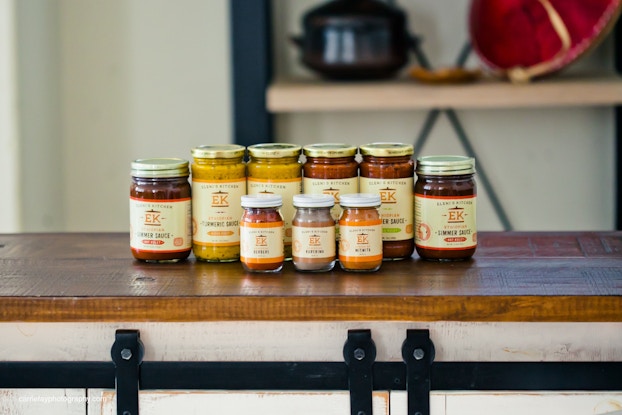
Why it matters:
- Products that create easy meals could reclaim some dollars younger consumers are spending on restaurant takeout, according to the National Restaurant Association.
- Packaged open, heat, and eat meals are a growing area of opportunity in at-home cooking convenience products.
- Consumers are turning to simmer sauces, bases, and other meal starters with global flavors to create interesting meals without complex recipes.
COVID-era stay-at-home mandates are widely believed to have gotten people stretching their cooking skills and comfort levels. Sheer boredom with preparing three meals a day at home for an extended time — combined with the realities of travel plans on hold and fewer restaurant options — led to experimentation in the kitchen. As life returned to more hectic, in-person schedules, that desire to create interesting meals remained, but not the time to devote to them.
Cue a plethora of convenience products — meal starters, mixes, bases, sauces, and frozen items that are taking center stage. Created with high-quality, healthy ingredients, and often global flavors, they are providing solutions for those who crave exciting food at home, without the hassle of complex recipes, equipment, or ingredient lists.
[Read more: How Manischewitz’s Rebrand Targets ‘Culturally Curious’ Younger Customers]
Consumers’ spending decisions indicate a desire for at-home convenience
While cooking at home has decreased since its peak in 2020 and 2021, 64% of Americans continue to do so, and 81% cook more than half of their meals at home, according to an “Eating at Home” industry report from the National Frozen and Refrigerated Foods Association.
At the same time, a look at where consumers are spending the bulk of their dining-out dollars reveals an opportunity for cooking convenience products. A statistical analysis from the Auguste Escoffier School of Culinary Arts says that 57% of food budgets are spent on food prepared away from home. The analysis dives deeper with National Restaurant Association data that shows more than half, 52%, of restaurant customers, especially millennials and Gen Z, say ordering takeout is an essential part of their lifestyle.
A picture starts to emerge of a consumer prioritizing convenience by purchasing food away from home that they want to enjoy at home.
A statistical analysis from the Auguste Escoffier School of Culinary Arts says that 57% of food budgets are spent on food prepared away from home.
Sauces, bases, and starters bring cooking shortcuts with bold international flavors
The cooking convenience trend cuts across a swath of categories, but ready-to-use meal starters, bases, and other sauces are at the forefront. According to Market Research Future, global research analysts, the size of the global cooking sauce market at retail is estimated to rise from $28.9 billion in 2023 to $43.2 billion by 2032. Growth in the category — which primarily comprises pasta and pizza sauces, stir-fries, marinades, and other sauces — is largely driven by rising demand for convenience and variety, as well as authenticity in global cuisine, said MRF’s Global Cooking Sauce Market Report.
An array of sauces and meal starters has allowed consumers to experiment with flavors from around the globe, like Asia, the Caribbean, and Africa. Examples include Mom’s Tikka Masala Meal Starter; Stick + Tine’s Beef Pho Vietnamese Soup Base; Pork Tonkotsu Japanese Ramen base from Fischer & Weiser; Food with Roots Jerk Marinade, created to capture island cuisine; Secret Aardvark‘s Drunken Garlic Black Bean Sauce, an Asian-inspired sauce that works as a marinade or for stir fries; and Eleni’s Kitchen‘s Ethiopian sauces, spices, and simmer sauces.
The impetus behind Eleni’s line was authenticity and ease of use.
“To create an Ethiopian stew, you have to start with the sauce as a base, which is complex, time-consuming, and requires a lot of ingredients that need to be sourced through ethnic markets,” said Eleni Woldeyes, Owner. The simmer sauces — available in mild, hot, and turmeric varieties — provide that in one jar as a base for a variety of stews.
Woldeyes also provides recipes online and information on labels — musts, she believes, to address the learning curve that accompanies global cooking sauces.
“Customers have some awareness of the cuisine if they tried it in a restaurant,” she noted, but most have not attempted to recreate it from scratch at home.
Michael Anderson also set out to bring an authentic recipe to the masses when he started Chilau Foods with his grandmother’s recipe for Crab Chilau (pronounced shi-la) in mind. The tomato-based seafood stew originated in Tampa’s Ybor City neighborhood and is a combination of the Cuban, Italian, Spanish, and African American cultures there. However, with a combination of tomato, onions, garlic, chiles, and other spices, Anderson soon realized he had a versatile stew base. “The flavor profile was bigger than one recipe,” he said.

At first, Anderson marketed the stew base as a seafood sauce until customers pointed out to him that “it’s for everything.” The biggest learning curve was getting people to taste, he recalled. “When they did, it was, ‘I know what to do with this. I know this flavor profile.’”
Experimentation with the product’s versatility led Anderson to launch with three products: original Chilau Stew Base for gumbos, soups, stews, gravies, and a variety of other meals; Creole Trinity for dishes like jambalaya; and Low Country Citrus, with a heat of sweetness inspired by Charleston and Savannah cuisines that works with dishes like shrimp and grits. He has since added Chilau Boil Base for crab and shrimp boil and offers an online recipe guide.
[Read more: Innovation and Artisan Options Driving Opportunity in Adult Nonalcoholic Beverages]
Frozen convenience moves beyond standard microwaveable entrees to items like homemade-style frosting
Frozen meals may be the ultimate convenience food, and they are going strong. For the 52 weeks ending September 8, 2024, frozen meals were the largest frozen food category in the U.S. with sales over $28 billion, according to Statista.
But the doors have opened for innovations beyond typical microwaveable meals. Eleni’s Woldeyes, for instance, noted that her frozen injera, a sour fermented spongy flatbread that is a staple of Ethiopian cuisine, is her most popular and easily understood product because of its heat-and-serve simplicity.
And frozen convenience is not limited to meals. Statista shows desserts are the second-largest category with $16.6 billion in sales, and innovations are ranging way past ice cream. While they were upping their home cooking skills during the pandemic, people were doing a lot of baking too. Now, as with restaurant-quality meals, bakery-level desserts that they can create easily at home have broad appeal.
Frost Buttercream Vanilla Bakery Frosting from True Treats is an example.
“I grew up baking with my mom, and the frosting was always another step,” said Founder Liv Truesdell.
Truesdell set out to make a frozen buttercream with clean ingredients like real butter and egg whites but free from artificial preservatives, dyes, and oils that can leave a greasy mouthfeel from some store-bought frostings. Home bakers defrost, whip, and spread, and leftover Frost can be refrigerated up to two months.
Customer feedback has been positive since the 2024 launch, but user education is required.
“It’s not the usual experience to buy frozen frosting,” noted Truesdell, who markets Frost as a convenience item. “It’s a meringue base, which can be an hour to make at home, but it tastes homemade,” she said.
Meal kits 2.0: ‘Packets to cook in the microwave is an area that’s really grown’
Traditional meal kit delivery services still have a market. Statista forecasts delivery services growing in the U.S. from $6.1 billion in 2025 to $7.6 billion by 2029, driven by the convenience factor.
But the next generation of heat-and-eat meals is taking the form of packaged products available at retail. In addition to simmer sauces, Maya Kaimal Foods offers rice, Everyday Dal varieties, and entrees like Korma Vegetable Curry in packs that can be opened and microwaved or heated on the stovetop.
Similarly, Lazy Food has created open, pour, and cook packaged plant-based pasta dishes. The trend extends to beverages too. BOBABAM is an at-home kit that lets people make authentic Taiwanese boba drinks at home.
“Packets to cook in the microwave is an area that’s really grown,” said Catharine Hamilton, Co-Owner of Putnam Market, a specialty grocer in Saratoga Springs, New York. “The trend is really a wider variety of foods from all over the world for increasingly sophisticated palates,” Hamilton continued. “And that comes in a lot of formats and categories.”
CO— aims to bring you inspiration from leading respected experts. However, before making any business decision, you should consult a professional who can advise you based on your individual situation.

Interested in a small business membership?
Find out how the U.S. Chamber of Commerce can help your company grow and thrive in today's rapidly-evolving business environment. Connect with our team to learn how a small business membership can benefit your bottom line and help you achieve your goals.







